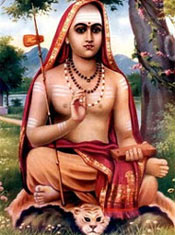Upanishads
The Upanishads are the only sacred books which addressed themselves exclusively to the discovery of essential spiritual truthsand to leading man to their realisation in his own life.
The message of the Upanishads is a study, verse by verse, of three of the principal Upanishads--Isa, Kena, and Katha The first contains 18, the second 35, and the third, 119 verses. Though constituting a small portion of the total Upanishadic literature, they yet contain a lucid exposition of all the essential ideas of this immortal literature.
The Principal Upanishads:
 |
The principal Upanishads are accepted to be those which Sankaracharya (A.D. 788-820) chose to comment upon; they are ten in number and enumerated in the Indian tradition as follows:
Isa, Kena,
katha Prasna Mundaka,
Mandukya, Taittiriya, Aitareya, Chandogya, and Brhadaranyaka.
According to some scholars, Sankara also commented on an 11th Upanishad, the Svetasvatara. In his commentary on the Brahma-Sutra, he refers to four more--Kausitaki, Jabala, Mahanarayana, and Paingala.
The lsa Upanishad embodies in its very opening verse the central theme of all the Upanishads, namely, the spiritual unity and solidarity of ail existence. The Kena illumines the nature of knowledge by pointing out the eternal knower behind all acts of knowing, and purifies man's concept of ultimate reality of all touch of finitude and relativity by revealing its character as the eternal Self of man and the Self of the universe.
The Katha holds a special fascination for all students of the Upanishads for its happy blend of charming poetry, deep mysticism, and profound philosophy; it contains a more unified exposition of Vedanta than any other single Upanishad. Its charm is heightened by the two characters of its dialogue, namely, old Yama, the teacher, and young Nachiketa, the student.
The Prasna, as its name Implies, is an Upanishad of questions; each of its six chapters comprises a question asked by each of a group of six inquiring students on various aspects of Vedanta, and the answers given by their teacher, the sage Pippalada.
The Mundaka, after classifying all knowledge Into para, higher, and apara, lower, and describing all science, art, literature, politics, and economics. infact, all positive knowledge, the knowledge of the changeful many--as apara, and boldly including even the holy Vedas and all sacred books in this category, proclaims that one knowledge as para, 'by which the imperishable changeless reality of the One behind the many is realized'. And the Upanishad sings in ecstasy the glorious vision of the One in the many.
In the brief compass of its 12 verses of condensed thought, the Mandukya surveys the whole of experience through a study of the three states of waking, dream, and dreamless sleep, and reveals the Atman, the true Self of man, the Turiya or the Fourth, as it puts it, as pure consciousness, eternal and nondual. It proclaims in its second verse the infinite dimension of man 10 a pregnant utterance--one of the four mahavakyas or 'great utterances' of the Upanishads-Ayam Atma Brahma.This Atman (Self of man) is Brahman.
The Taittiriya after majestically proclaiming that 'the knower of Brahman attains the Supreme' (Brahmavidapnoti param), describes the five kosas or sheaths that enclose and hide Brahman, and demonstrates the technique of piercing these sheaths of relativity and finitude with a view to reaching the infinite and the eternal at the core of experience. It also provides a scientific definition of Brahman as 'that from which all these beings are born, by which, after being born, they live, and into which they merge when they cease to be.'
The Aitareya establishes the spiritual character of the Absolute through a discussion of the nature of the Self of man, and proclaims this truth in another of the four mahavakyas(V3): Prajnanam Brahma: 'Brahman is pure Consciousness.'
The Chandogya introduces us to charming truth-seekers, such as Satyakama, Svetaketu, and Narada, and outstanding spiritual teachers, such as Aruni, Sanatkumara, and Prajapati. Through several illuminating teacher-student dialogues, the Upanishad helps us to discriminate the reality of being from the appearance of becoming. In a brief utterance of deep Spiritual and philosophical import, treated as another of the four mahavakyas, it sings in refrain the divinity of man: Tat Tvam Asi-- That thou art'. It prescribes a knowledge of this innate divinity of man as the one remedy for the deeper ills of life:Tarati Sokam Atmavit-- The knower of the Atman crosses all , sorrow.
In its profoundly human episode of the discipleship of Indra under Prajapati, it instructs us in the true nature and technique of man's spiritual quest and the blessings that flow from spirituality. It is an impressive account of man's spiritual education, his growth from worldliness to spirituality. It points out the limitations of materialism as a philosophy of life and the evils that flow from it.

